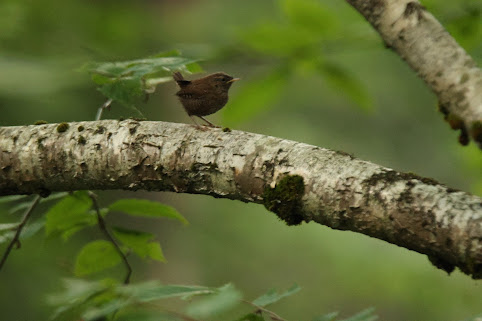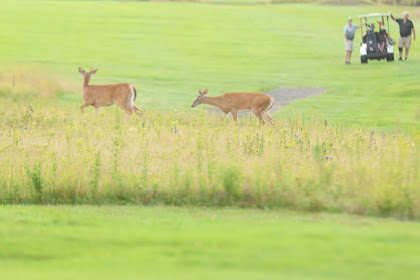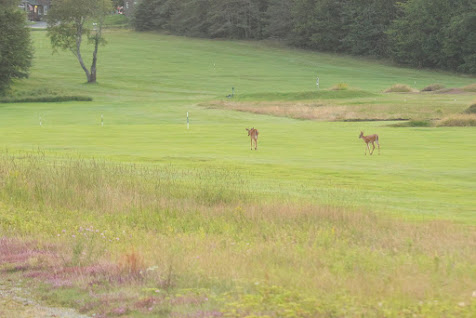Loons, Waxwings, and Whitetails In The Adirondacks
From the 4th to the 7th of August, I went to Lake Placid, NY. Lake Placid is a small town in the Adirondacks, famous for being the location of the 1980 Winter Olympics. I could not get around to doing any wildlife photography until the second evening I was there. I had heard rumors about loons hanging out on mirror lake, the one that Lake Placid (the town) wraps around, so I decided to rent a kayak for an hour, and paddle around the entire lake. No loons, but I eventually found a flock of first year Mallards. These are the males and females who were born this year. The males have not
I then found a juvenile Canada Goose on the other side of the lake. It is still significantly smaller than the geese I am used to seeing, and had some down feathers on its head.
There were some more mallards, moving along the shoreline of the main town. I decided to put the ducks between me and the setting sun, to take backlit photos of them, lighting only the outline of the ducks...
After a few minutes, the backlit conditions were ruined by a cloud, which blocked the sun.
I realized my hour was up, so I parked my kayak, and looked for hiking spots on google maps. I decided to check out a heath near lake placid, called Stateline Trailhead. My hope was to find deer or moose, feeding in the heath. I drove there, and bushwhacked down to the water. When I looked out onto it, I did not see anything.
Heaths are formed when a wooded area stays flooded with shallow water for a very long time. Sphagnum moss eventually covers the heath, and then creates the conditions for other plants to grow, like the round leafed sundew (a carnivorous plant) , and subalpine larch trees.
A closeup view of the subalpine larch tree's odd looking branches...
I followed the path through the woods, as the sun began to set. The area was dominated by gray birch. I found my first pacific wren, and an American red squirrel...
Finally, the dead silence was interrupted by a loud crunching noise. A whitetail deer had been feeding only 20 feet away from the path, and sprinted out of the thick woods, lifting it's white tail in distress. It ran into a clearing up ahead. I quietly moved towards the clearing, and found that the clearing went for acres in every direction. I had found an overgrown golf course, dominated by wildflowers, spruce saplings, and tall grass.
I finally spotted the deer again. A young buck. There were some golfers about 100 feet away in the opposite direction, packing up there clubs to leave, and the buck was cornered, wanting to keep its distance from both me and the golfers. It moved out of the woods, and started wandering towards some spruce trees for cover...
A second deer trotted out of the woods, catching up with the buck. This one was a whitetail doe.
Luckily, they did not spook, and were very habituated for rural deer. Normally, ive found that the closer a deer is to a city, the more comfortable it is around people. These deer were definately on the chill side, even though they live out in the middle of the Adirondacks. They must spend a lot of time on the golf course, running into people constantly. The pair wandered into an area that was very photogenic, with tall wildflowers, and grass, and spruce trees planted sparsely. I started getting photos that I'm really happy with...
I took some video for Instagram reels, struggling to keep the buck in focus...
I started to get closer, and I caught the attention of the doe.
Her and the buck suddenly seemed curious about me, and started to walk closer, until they were only maybe 30 to 40 feet away. I tried to close that distance even more, by slowly walking towards them. They froze for a while, and became cautious.
After about a full minute of being as still and quiet as possible, the doe took off running for cover. She put up her white tail, to get the buck to follow her out.
After a little while of walking across the gulf course, away from me, they finally disappeared into the woods...
I then headed home, and planned to return the next day. Unfortunately, I could not go back the next day, because I could not use the car in the evening. I did however, go driving in the early afternoon, along a road that went along the side of a lake. I scanned the lake for any white spots, or anything that could be a loon. I did not see any loons at first, but I saw a cormorant sunning itself. I pulled over immediately to take photos of it. When I brought my camera down to the water's edge, I immediately forgot about the cormorant, because a mated pair of loons was only about 20 feet away, fishing just past the reeds. This was way closer than I ever expected to get to a wild loon, and I had to zoom my lens all the way out to 150mm to fit both loons in the frame.
I tried to get to eye level, but by the time I was able to get to the water's edge and lie down, they had spooked, and were headed for the protection of deeper water.
They then headed down the lake, diving over and over as they started to fish. They joined the cormorant in an area that was about 200 feet away from my position. I think that there must have been a school of fish in that area, because the loons seemed to keep following the cormorant for a long time.
As I was following the fishing birds, jogging along the road's edge, I noticed a head poking up from the reeds. A great blue heron was also trying to fish.
Over the course of a few minutes, I slowly and quietly climbed down the cliffside, to the marshy area that the heron was standing in. The heron was surprisingly relaxed. Again, I was expecting it to be very skittish, living in an area with very few people.
Soon though, I pushed my luck, and got a little too close. I think the heron flying spooked the cormorant, because it too took off flying to another part of the lake.
I checked in on the loons again, and saw that one of them had caught something. I am pretty sure that it was a bluegill, or at least some kind of sunfish. It took the loon about 10 minutes of struggling to get the fish down, during which I was only able to take low quality photos since I was so far away.
The pair then made their way to the opposite end of the lake, Where I was able to get close again...
A lone cedar waxwing was perched on a dead tree, overlooking the lake, giving me the opportunity for one of my favorite photos of the year...
Eventually, the loons settles down. One of them quickly fell asleep...
... while the other started preening. I think something was wrong with the preening loon, because it was thrashing around violently for a little while. Maybe it was injured? Here is a video of the behavior...
Whatever it was, it made for some pretty dramatic photos, as the loon splashed and kicked relentlessly...
thankfully, It's preening seemed to shift to a more normal routine after a while. The loon would lean its head back, to clean its feathers, and then fluff itself out, by rising out of the water until it was standing upright, and then vigorously flapping, to dry itself, and shake off any loose feathers.
...I decided to call it a day after I got that shot.
On the last day I had in the Adirondacks, I decided to wake up at 5:00am, and hit both the golf course, and the lake. I was on the road while the sky was still pitch black, and I arrived at the golf course just in time to catch the sunrise...
The only thing i could find was one lone buck, who ran off into the woods when approached...
I then stopped by at the lake again, to check out the loons. I finished off the trip by getting way closer loon photos than the day before...
.jpeg)






.jpeg)
.jpeg)
.jpeg)
.jpeg)
.jpeg)







.jpeg)
.jpeg)


.jpeg)
.jpeg)
.jpeg)
.jpeg)


























.jpeg)



.jpeg)

.jpeg)

Comments
Post a Comment